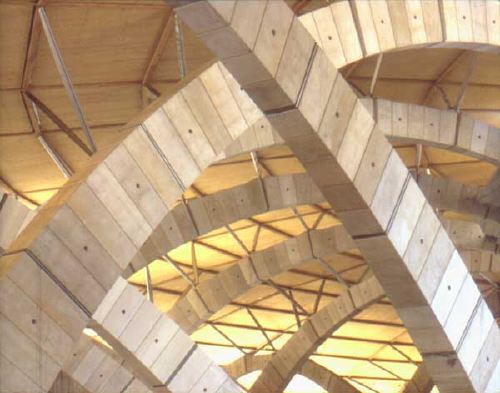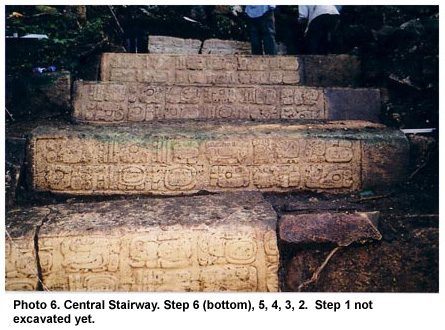 From a BBC report: Protestors spray painted anti-war grafitti at Etaples in Northern France, the largest British WWI memorial cemetery in the country.
From a BBC report: Protestors spray painted anti-war grafitti at Etaples in Northern France, the largest British WWI memorial cemetery in the country.
What it said (in order of increasing shock and awe) “Sadaam will win and spill your blood,” “Death to Yankees (swastika included),” “Bush, Blair to the TPI [International Court of Justice],” “Rosbeefs [what the French call Brits when they hear ‘frog’] Go Home,” and “Disinterr your trash, it contaminates our soil.” The French are suitably pissed, as are the British. [thanks, Buzz.]
“”Had the public been able to see live coverage from the [first world war] trenches, I wonder for how long the governments of Asquith and Lloyd George could have maintained the war effort. Imagine the carnage of the Somme on Sky and BBC News 24.”
— Jack Straw, British Foreign Minister in the the Guardian. Read the full text. Remember that nothing remotely Somme-like has been seen on western TV.
See the Silent Cities site for the Etaples Military Cemetery. The Commonwealth War Graves Commission, which administers Etaple (and Thiepval, the memorial at the Somme which was the object of Souvenir (November 2001)).
Category: souvenir (november 2001)
On The French And WWII (and WWI)
When Maciej started French Week (“fighting francophobia since wednesday”), Jason linked to the first installment, “Ten Reasons to Love France,” which was a breezy response to the frivolous tone of the fries/toast/kiss gag.
It’s not funny anymore. From day two, “WWII, the Real Story”
…But there’s a more profound, indirect reason for the French defeat [in 1940], which explains why the German armies were able to score this tactical coup in the first place. And that reason is the French experience in World War I.
World War I has almost comical connotations in our own popular culture. American doughboys, kaisers and marshals in funny hats, the Red Baron. But for France, the Great War was the most traumatic event of the twentieth century. No country lost as great a proportion of its population in that war: 1,400,000 men were killed outright, two million were wounded. A million of the wounded had debilitating injuries, and could never work again. They were a lost generation, and a living reminder to others of what war really meant.
On Remembering Or Repeating History
 History shows that a war which follows on the heels of a Serbian assassination doesn’t go well for anyone involved.
History shows that a war which follows on the heels of a Serbian assassination doesn’t go well for anyone involved.
As I’ve written before, one reason I chose a WWI battlefield as an object of my first film, Souvenir (November 2001), was because it had been “forgotten.” Practically speaking, there is no one left alive who has direct experience or memory of WWI in general and the Battle of the Somme in particular. At best, it’s taught, analyzed, considered, memorialized, but it is not remembered.
Generally, in the US, if WWI’s known at all, it’s as dim, dusty, unfortunate history, where “history” translates as “has nothing to do with what’s going on right now.” In this absence of memory, attempts to liken the current political/military situation to WWI are countered with pious promises to “never let such a horror happen again.” But those promises are almost never accompanied by an understanding of why or how WWI unfolded, or even what such a horror actually comprised.
 Such benign ignorance afflicts the New Yorker protagonist in S(N01), whose “search” for The Memorial to The Missing at Thiepval is driven by his own involvement in the “most horrible violence ever.” He ambles in a naive daze across the modern era’s first “most horrible violence ever,” and finds not just one memorial, but hundreds: countless markers and cemeteries; fields still yielding up remains; razed and rebuilt towns; and rare, preserved sections of battlefied What’s more, though, as he drives his German car across France, he finds people–French locals and British caretakers–who show the 80-years-on effects of the war, which–they’re painfully aware–are nigh-unbearable, even when your side “wins.” They also show the New Yorker a welcoming-but-pained sympathy, as if he’s rushed home with bad news, only to find a passel of neighbors and friends waiting to tell him something even worse.
Such benign ignorance afflicts the New Yorker protagonist in S(N01), whose “search” for The Memorial to The Missing at Thiepval is driven by his own involvement in the “most horrible violence ever.” He ambles in a naive daze across the modern era’s first “most horrible violence ever,” and finds not just one memorial, but hundreds: countless markers and cemeteries; fields still yielding up remains; razed and rebuilt towns; and rare, preserved sections of battlefied What’s more, though, as he drives his German car across France, he finds people–French locals and British caretakers–who show the 80-years-on effects of the war, which–they’re painfully aware–are nigh-unbearable, even when your side “wins.” They also show the New Yorker a welcoming-but-pained sympathy, as if he’s rushed home with bad news, only to find a passel of neighbors and friends waiting to tell him something even worse.
 Lutyens’ Memorial to The Missing of The Somme is powerful; visiting can be an overwhelming experience. But its power pales in comparison to the concerted efforts to teach about WWI that take place in every school in the UK. The Lochnagar Crater now sits alone as a souvenir in the landscape, a scar that–according to those who visit it or live around it–still aches, recalling them of old wounds. But its influence pales compared to the effect of a lifetime where every errand you run in your entirely-post-war village takes you past half a dozen cemeteries, and where, spring after spring, you turn up mortars and rotted boots when you plant your flowers.
Lutyens’ Memorial to The Missing of The Somme is powerful; visiting can be an overwhelming experience. But its power pales in comparison to the concerted efforts to teach about WWI that take place in every school in the UK. The Lochnagar Crater now sits alone as a souvenir in the landscape, a scar that–according to those who visit it or live around it–still aches, recalling them of old wounds. But its influence pales compared to the effect of a lifetime where every errand you run in your entirely-post-war village takes you past half a dozen cemeteries, and where, spring after spring, you turn up mortars and rotted boots when you plant your flowers.
When I made S(N01) exactly a year ago, I was nervous about drawing false parallels between the attacks on New York and an “actual” war. Tragedy was tragedy, loss was loss, but a terrorist attack was not The Somme. 2001 wasn’t 1914, I mean, how could it be, when the civilized world was united? I expected the need for S(N01)‘s solace would pass: we’d learn to deal with the loss of September 11th, and move gingerly toward a safer, more peaceful future. The movie’d become a time capsule, a sad-but-nostalgic reminder of the moments of our resolve. Instead, I wonder if I’ve unintentionally remade someone’s film, Souvenir (July 1914).
Souvenir (November 2001) Screening Recap
I’m quite behind, obviously. Thursday went very well, as I wrote earlier. Souvenir (November 2001) screened last in a program of four short films which, in the words of Festival Director (and MoMA curator) Sally Berger, were “different from all the Sept. 11-related things we’ve been saturated with…These ‘makers use a more essayistic, and in one case [mine, -ed.], narrative form to explore issues and ideas.” The other three films were:
Before the screening, I met David and Etienne in the theater, when we were caught off guard by the opening music from Souvenir; the projectionist was checking the levels. Family showed up, a wave of people I didn’t know, then a couple of familiar faces. The whole thing was more nervewracking than I’d imagined. Sally Berger got up to introduce the films, then we were off.
I was very interested to see the other three films, which were very different from each other and very good in their own ways. Inevitably, I was caught up, trying to anticipate what kind of context the program was creating for my film. (The only line I remember from Beaches: “But enough about me, let’s talk about you. What do you think of me?”) The various settings, pacing, tone and styles worked well, though, and people seemed to take Souvenir in quite readily.
Watching it on the big (did I say big, I meant HUGE) screen was intoxicating; repeatedly, self-consciousness would build (“oh no, this shot’ll be too long!”), and then a gorgeous image or a nice cut would come. People reacted to lines I worried were too obscure. A couple of shots were kind of dark, but if you look back to the location notes, lighting was one of our major challenges then, too.
Then, it was over. Lights came on, the woman in front of us bolted, I knew no one’d stay for the Q&A, and they did. Norman and Etienne both took questions, Sally talked about putting the program together, and then people asked about Souvenir, how memorials change over time, what French people thought, what should happen on the WTC site, about repeated references to emptiness and voids in the film (something I hadn’t really considered), and then it was over. People came up, we got shooed to the lobby, we talked and talked, there were hangers on, it was very, very cool. Just like you’d see in a movie. theater.
Wellwishers Multiplying Like Rabbits
Thanks to all y’all (as we’d say in NC, at least when our parents weren’t around) who’ve sent your kind wishes and congratulations re Souvenir. Since 1) You mailed from work, 2) you mailed from outside New York, and 3) there were far more of you than bodies in the theater, I conclude most of you weren’t actually at MoMA yesterday. So thanks for the vote of confidence, too, I guess.
So far, the winner of the farthest-away-wellwisher goes to Aussie Matthew Clayfield, who writes about his prodigious film production activities on his weblog, Esoteric Rabbit Films. According to his site, he has yet to graduate to wearing pants. He’s 16.
Souvenir Screening: (Too Much) Like A Dream (Team)
I’m beat, but I have to mention one experience from the premiere that caught me totally offguard. My film, Souvenir was shown with three other short films, including Etienne Sauret and David Carrara’s haunting WTC: The First 24 Hours. Sauret captured the empty shock and silence of Ground Zero, images of a time and place otherwise closed to the media, like these fragments of the Towers’ trademark steel columns.

Still, WTC: The First 24 Hours, dir. by Etienne Sauret. Image: thefirst24hours.com
Then in Souvenir, this MIT webpage briefly flashed across the screen during the Google search. Professor Helene Lipstadt had helped students build the Reflecting Wall, a painted wooden replica of these columns, which went up within three days of the attacks.
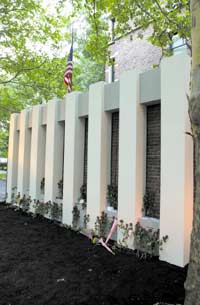
MIT’s Reflecting Wall, Sept. 14, 2001 Image: Donna Coveney, MIT
My mind went immediately to the the WTC proposal put forward yesterday by Richard Meier, Charles Gwathmey, Steven Holl, and Peter Eisenman.
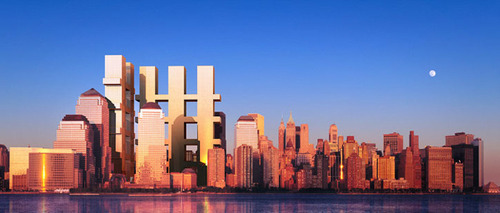
Meier, Gwathmey, Holl and Eisenman WTC Proposal image: LMDC
There’s no mention of such a reference at all in either their presentation or their written proposal. Instead, they refer to “a new typology in the tradition of innovative skyscraper design…quiet abstraction…screens of presence and absence…[and] interlaced fingers of protective hands.” So this “Dream Team” never imagined their proposal for rebuilding closely references the wreckage of the Twin Towers? You must be dreaming.
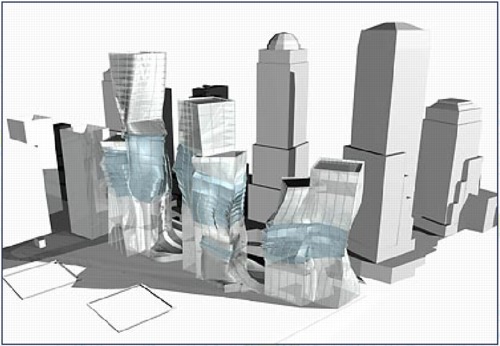
“Partly collapsed” office towers, by Peter Eisenman. NYT caption: “…the buildings would echo the devastation wrought on 9/11 and offer a striking memorial to the fallen towers.”
In September, Eisenman contributed a design for office buildings on West Street (facing Ground Zero) to NY Times critic Herbert Muschamp’ ambitious exercise, “Don’t Rebuild. Reimagine.”. In the Magazine’s Flash presentation, Eisenman describes the buildings:
You get the effect of …a moment of frozen time, where the buildings are collapsing, and what we tried to do was record in the buildings that moment, a moment of impact on the surrounding buildings that would be recorded as part of the memorial.
Even though they avoid mentioning it, the “Dream Team” has proposed to freeze a different moment in time, the first 24 hours.
Post Script: A reader (from Eisenman’s Yale, by the way) pointed out another connection, one that I didn’t make yesterday: the formal similarities to Steven Holl’s just-finished building, a dorm at MIT.
Souvenir (November 2001) World PREMIERED
Three-line synopsis: It went amazingly well; about 60 strangers(!); a couple of media, and interest from one critic; three very interesting companion films in the program; chuckles in the right places; thoughtful questions afterward; and supportive friends, crew, and family. Oh, and Sally Berger, organizer of the Festival called it “wonderful and moving.”
We’re going to dinner now, then I’ll return to earth and give more details.
Documentary Fortnight, Last Night
Last night was the filmmakers’ reception for Documentary Fortnight, which followed a screening of Family, by Sami Saif and (So)Phie Ambo (see below). The film was pretty good; the nervous Sami’s emotionally high-pitched quest to find his Yemeni father. Arriving in Yemen, Sami tells one of many “uncles” how he, his brother, and his Danish mother suffered after his father ditched them in Denmark. With girlfriend Sophie behind the camera, the film has an uncomfortably intimate feeling, well suited to its raw subject.
 At the party, I met several of the other filmmakers, and we traded notes on the festival, the audiences, Sundance, and PR stunts (more on this later). One standout: Satoshi Ono, whose film Danchizake (Homemade Sake) screened last Friday. It’s a contemplative story of his family’s relationships which reveals itself as his father brews sake. Jeff Hatfield, friend/cameraman on my documentary/artist, came with me, and, wouldn’t you know it, he’s exhibited a fully functional moonshine still in a couple of museums, so they had a lot to talk about.
At the party, I met several of the other filmmakers, and we traded notes on the festival, the audiences, Sundance, and PR stunts (more on this later). One standout: Satoshi Ono, whose film Danchizake (Homemade Sake) screened last Friday. It’s a contemplative story of his family’s relationships which reveals itself as his father brews sake. Jeff Hatfield, friend/cameraman on my documentary/artist, came with me, and, wouldn’t you know it, he’s exhibited a fully functional moonshine still in a couple of museums, so they had a lot to talk about.
Ono’s next film will be about his grandparents, (similar to my first project) so we definitely had a lot to talk about. When the Festival folks heard us speaking Japanese, they freaked out, wondering why I hadn’t mentioned it before. (Apparently, there was only budget enough to get a translator for one day, and they’d been doing a lot of sign language.)
Anyway, when I told a couple of other directors about my film and the upcoming presentation of architects’ designs for Ground Zero, they invariably suggested passing out cards for Souvenir at the World Financial Center event. Sounds good to me, so watch for the Kozmo.com jacket again. Remember: Souvenir is screening Thursday at 2PM…
On Short Films, Mine and Others
 Documentary Fortnight at MoMA is underway. The first event I’ll be attending is tomorrow (sun.) night, a screening of Family by Sami Martin Saif and Phie Ambo. After the deaths of his mother and brother, Saif travels from Denmark to Yemen to find his father. There’s a filmmaker reception after that. I’ll give you a report. Let me know if you’re going, or look for me there. That’s me in the orange Kozmo.com jacket.
Documentary Fortnight at MoMA is underway. The first event I’ll be attending is tomorrow (sun.) night, a screening of Family by Sami Martin Saif and Phie Ambo. After the deaths of his mother and brother, Saif travels from Denmark to Yemen to find his father. There’s a filmmaker reception after that. I’ll give you a report. Let me know if you’re going, or look for me there. That’s me in the orange Kozmo.com jacket.
Blocking out the production schedule for Souvenir January 2003, the next short, which will be shot in Springville, Utah (aka “Art City”). Here’s the script. For reference, check out the documentary in the Projects column at left.
In the Guardian, Duncan Campbell reviews 11″09″01, the collection of 11 Sept. 11-related short films produced by Alain Brigand, and loudly laments its lack of US distribution prospects. [The film’s site has interviews will all eleven filmmakers. In French.] Frankly, I’m still pissed that I missed a screening last month at Columbia.

image: bacfilms.com
Campbell mentions the Sean Penn installment I wrote about earlier (starring Ernest Borgnine, the new greg.org poster boy). Penn remembers that loss “occurs every day, and the suffering that follows.” Here’s the Read Google translation of Penn’s director statement.

image: bacfilms.com
In her short, Mira Nair tells the true story of a Muslim New Yorker’s unexplained disappearance on September 11. [Read about her latest feature, Monsoon Wedding, in Filmmaker Magazine.
Alejandro Gonzalez Inarritu‘s segment has repeatedly been singled out as the most powerful in the film; sounds and voices over a black screen punctuated by fleeting clips of people jumping from the towers. A question appears on the screen at the end, “Does God’s light blind us or guide us?” It’s a question Inarritu intends for both sides, since both invoke God in a battle of good and evil.

Kissinger sharing the spotlight with Chilean dictator Augusto Pinochet
Ken Loach must have found Henry Kissinger’s brief appointment to a September 11th commission to be a cruel joke. His segment deals with the one of Kissinger’s pet projects for Nixon, the bloody 1973 overthrow of the civilian government in Chile, which cost over 30,000 lives. [Read Seymour Hersh’s <1982 Atlantic article about Kissinger driving the coup.] It took place on Sept. 11.
Tilting at Windmills: Script Annotation and PR for Souvenir Premiere

Have spent most of yesterday and today writing, researching, annotating the AM script. As discussed before, it’s based partly on a real-life crime story, so it’s critical from a CYA standpoint to document the sources of characters, facts, events, and evidence in the publically available record. It’s a rather laborious process, but fortunately, I’ve kept a fairly comprehensive file of source material for the last 2+ years. Obviously, I didn’t imagine using it for a movie–much less an animated musical–until very recently. And to those with deep misgivings about an animated musical based on a true-crime story, bad Star Treks, The Umbrellas of Cherbourg and Citizen Kane, I say, welcome to my world.
In addition, I’ve been working on updated press kits, press screening copies of the movie, prouction stills, mailing lists, bios, PR ideas, and other planning for the MoMA Documentary Fortnight premiere. The Museum’s releasing the full list of films to be screened this week. Stay tuned. And if you have any ideas or comments on PR/press, please chime in.
Souvenir (November 2001) to premier at MoMA’s Documentary Fortnight
Just got formal notification, although I was contacted a couple of weeks ago. The Documentary Fortnight runs from Dec 13-23, and Souvenir will screen December 19th. From what I understand, they have put together a program of three WTC/September 11-themed films, including mine.
The Director apparently heard about the movie after the preview screening of the nearly completed version in June.
Needless to say, I’m stoked. Stay tuned for more info and updates, and start making your Christmas in New York travel arrangements now.
On Invention learning who his mother is the hard way
 to
to 
Finished the MemeFeeder project on time. The scene I thought I’d do turned out not to be the scene I’d actually been asked to do, although I only saw the email with the actual scene assignment yesterday. So, no sooner did I complete the shoot, then I found out I had to do it all over again, with a scene I’d never thought about. And, I’d have to do it in <1 day. This, after I completely rethought and shot the 1-minute scene (#3, titled “Commute”) and shot it in a way that 1) didn’t require going to CT and JFK; 2) didn’t require editing, since my Final Cut Pro computer wasn’t available enough, 3) fit the images in the storyboard, and 4) would be interesting. Wanna see what I came up with? Watch it here. (It’s a crappy 1.1mb quicktime file).
 to
to 
So, I had about 12 hours to come up with the scene above (#7, titled “Escape!”), with all the restrictions above, and on a cold rainy night. So I took a different take on the title, “Escape!” The story is, well, it’s pretty self explanatory. I am pretty happy with it, frankly. I edited it entirely in the camera (using only the “Record” button). Watch the scene here (again, in crappy quicktime).
I have no idea what the MemeFeeder folks’ll think, but you should definitely check out the completed project (which launches Monday, Oct. 14). It’s been nervewracking, but a lot of fun.
On Arches, Now and Then
The architect Renzo Piano is conspicuously absent from both the discussion and the process of rebuilding New York City. Conspicuous because he has already designed Manhattan’s next important skyscraper, the headquarters for the NY Times [see the model]. Conspicuous because he is clearly one of The Times’ critic Herbert Muschamp’s favored architects (“Piano is a humanist, perhaps the leading exemplar of that tradition in our time.”) Conspicuous because he developed the master plan for what is the only recent urban undertaking of comparable scale, Berlin’s Potsdamer Platz. Conspicuous because his innovative, forward thinking design for extremely conservative clients (the followers or the controversial saint, Padre Pio) is being hailed as a miraculous masterpiece by the Guardian before it’s even completed. (That Muschamp link above praises it, too. While I like Kansai Airport, my favorite Piano work is still the Menil Collection in Houston. It’s subtly but completely transformative.)
For this massive (6,000-person) pilgrimage chapel, Piano reinvented and reinvigorated the use of the arch–specifically the stone compression arch–a technique with a 2,000-year old legacy. Another interesting characteristic is the building’s discrete siting; “In fact,” Piano says, “it will not be visible until visitors are very close.” These remind me of another “pilgrimage site.”
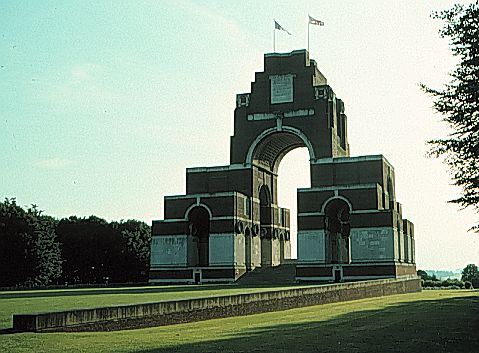
Memorial to the Missing, Sir Edwin Lutyens, 1932
Lutyens’ Memorial to the Missing at Thiepval has been called the “most imaginative and daring use of the arch form.” According to Alan Borg’s War Memorials, the venerable Lutyens took a thoroughly modern approach to an ancient form, infusing the Roman triumphal arch with the essence of even more ancient burial mound architecture. And like Piano’s chapel, the Thiepval memorial is meant to reveal itself (and its lesson on the wages of war) only gradually.
Last December, according to Muschamp, Piano said the architects who could design well for Ground Zero are now only 4 or 5 years old. I don’t think that’s right. Piano also said, (rightly) “Whatever is built, there should first be a great deal of thought and reflection. It’s not only an economic issue but a cultural one. What is at stake is saving the soul of a city, its spirit.”
Lutyens completed Thiepval nearly 14 years after the war ended; he was in his sixties. Considering it’s the exact opposite idea I had when I decided to make a movie about Thiepval, I surprise myself. I wonder if what Manhattan needs is a Lutyens, and if Renzo Piano is it. I hope I’m wrong, because he’s nowhere near the place.
“If I am lonely in a foreign country, I search for ruins.”
The quote is from Christopher Woodward’s book, In Ruins, which was sensitively reviewed in the New York Times. Cited near the end of the review, the line resonated with both the story in my short film Souvenir and my own experience. It reminded me of an overheard comment from almost exactly a year ago, “I just wanted to be a part of it.” The great part of Woodward’s book deals with the “pleasurable pain” ruins evoked as late as the 19th century, when “modernizing” civilization finally yielded a city larger than 4th century Rome or a building larger than the Colosseum.
In the Somme (where parts of Souvenir take place), there are almost no ruins. Unlike Verdun, which the French quickly covered with a bell jar of remembrance, the Somme was pretty much rebuilt, monumented, or plowed under. In reviewing Woodward’s book, Richard Eder writes that modern society (ie., weapons+tactics+building technology) may have made ruins obsolete, to our detriment: “With nuclear weapons or box cutters we are able to annihilate the past as well as the present.”
In the review (and presumably, in the book, too), these lessons don’t really jump out, but instead come into view, like a Mayan temple engulfed by the jungle. On September 10th, archeologists reported a major discovery, carvings that reshape the history of Dos Pilas, a Mayan ruin in Gautemala. The carvings came to light after the country suffered widespread devastation last year from Hurricane Iris. Sometimes it’s only in the aftermath of destruction that modern society even thinks to learn lessons from the past. Or as Woodward puts it, “When we contemplate ruins, we contemplate our own future.”
a void with no building in it, a building with a void in it, a quiet place with some statues in it
A NY Times account of “Monument and Memory,” a panel discussion presented by the Columbia Seminar. Jewish Museum architect Daniel Libeskind cited his own powerfully programmatic work in arguing architecture’s ability to deal with trauma and memory. TheNew Republic’s Leon Wieseltier demanded a void and a flag, lashing back at Libeskind’s (and, by proxy, Architecture’s) reflexive “materialism” and egotism. (Libeskind apparently didn’t win many points for rhetorically bitch-slapping the pensive philosopher on the panel, either.)
While I tend to agree with Wieseltier’s ideas, he also did say (just a couple of weeks ago) that “what rises from the abyss of Ground Zero will become the most revealing American urban expression of our times.” Is that a void? I don’t think so. And a “void with a flag” cannot avoid instilling a sensory/emotional/political experience on its visitors any more than a didactic monument can. In Souvenir (November 2001), these two ideas–the preserved void (Lochnagar Crater) and the programmatic Memorial (Lutyens’ Memorial to the Missing)–are juxtaposed without finding a clearcut answer as to which “worked better.” [Here’s an account of shooting those scenes.] Libeskind turns out to be much more like Lutyens than I’d imagined. At least in architecture, there may be very little new under the sun after all.

